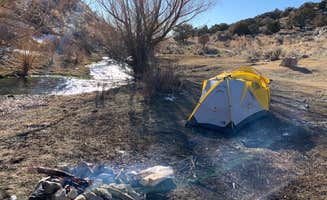Dispersed tent camping near Wells, Nevada primarily centers around the East Humboldt and Ruby Mountains. The area features high desert terrain at elevations ranging from 5,600 to over 11,000 feet, creating significant temperature variations between seasons and from day to night. Most primitive campsites remain accessible from late spring through early fall, with winter conditions limiting access to many locations without specialized vehicles or equipment.
What to do
Stargazing opportunities: The remote location of East Humboldt Wilderness Dispersed Camping provides exceptional night sky viewing. "Fantastic Milky Way star gazing on a clear night," reports one camper who enjoyed solo camping in the area.
Hot spring soaking: Visitors to 12 Mile Hot Springs Dispersed Camping can alternate between hiking and relaxing in thermal waters. According to a recent visitor, "Clean, pretty spot by the creek. Which is nice and warm from the spring. And a short walk for a dip in the hotspring."
Hiking exploration: The wilderness areas surrounding tent sites offer numerous unmarked trails. "Took a hike and explored. I also took a bath in the hot springs. If you are in the area, this is a must stay at," shares a camper who visited during summer.
What campers like
Natural springs and warm water: The geothermal features near Wells provide unique camping experiences. One reviewer at 12 Mile Hot Springs noted, "The creek water is warm from the hot spring and made for some fun exploring and even cooling off on a hot July day!"
Peace and solitude: Most dispersed camping areas offer significant separation from other campers. "Great spot - fantastic views and a little wetland over the valley. Only one spot, and free grazing cows," reports a camper who stayed at East Humboldt Wilderness.
Wildlife encounters: Free-range cattle frequently visit camping areas. "There are free-roaming cows in the area, which added a unique touch—they kept to themselves, and we did the same," mentions a camper who enjoyed the rustic experience.
What you should know
Vehicle requirements critical: Most access roads demand high-clearance transportation. "Epic spot. Got all the way to the hot spring with a non-modified 4WD w/ decent clearance and a skilled driver, but it is September so the water crossings were low," explains one visitor to Humboldt-Toiyabe National Forest Terraces Picnic and Group Camping Site.
Reservation challenges: Some areas have confusing systems. A reviewer noted, "The reservation situation here is a bit confusing. Dyrt makes it out to be a group site, which it is, but it can also be reserved as up to nine individual sites if a group hasn't already laid their claim."
Seasonal road closures: Winter weather impacts access. "Road out to angel lake closed so was humboldt loop," reports a visitor attempting to reach camping areas during spring shoulder season.
Tips for camping with families
Weekday planning benefits: Timing matters significantly for tent camping Wells, Nevada experiences. A camper shared, "We camped right next to the warm creek, about a quarter mile before the hot spring and walked to the spring several times a day. There were days when we had the spring all to ourselves, weekends got crowded."
Natural water features for children: Warm creeks provide safer water play than hot springs themselves. "At least 6 dispersed sites on the road leading to 12 mile hot spring. If you get lucky, there is one spot at the springs and a few past the spring," notes a family who found ideal camping locations.
Wildlife awareness necessary: Animals frequent these areas regularly. "The cows were a little scary and we saw a snake," cautions one camper about unexpected wildlife encounters at Raw Retreat Repeat.
Tips from RVers
Limited suitable sites: Most primitive camping areas near Wells accommodate tent camping rather than recreational vehicles. "There's a big spot for a U Turn as well," notes one traveler who managed to navigate a small sedan to a dispersed site.
Alternative options necessary: RV campers should consider established campgrounds. "The perfect place for a stop-over after a day of driving or adventuring," suggests a reviewer describing one of the few areas that can accommodate vehicles larger than passenger cars.
Creek crossing assessments: Water levels determine passability. "The road is extremely difficult/had three creek crossings about ankle to knee deep. We made it all the way back and had the place to ourselves!" reports a camper who successfully navigated water obstacles.


